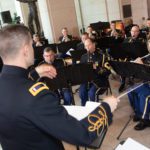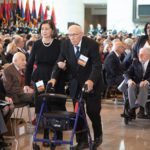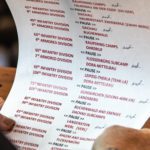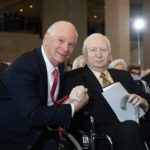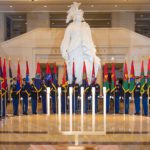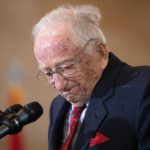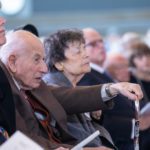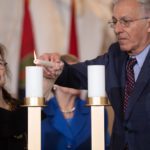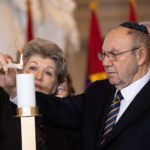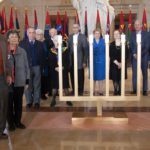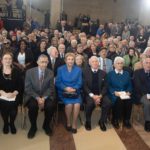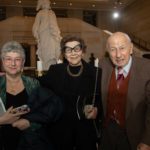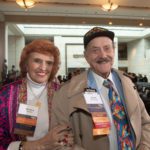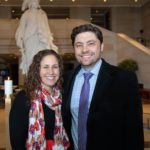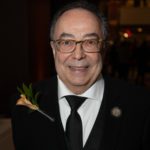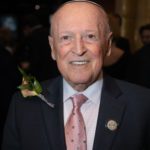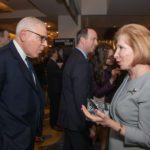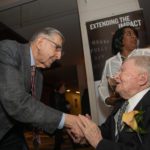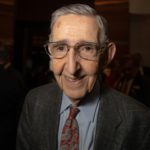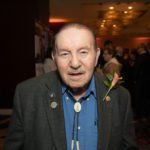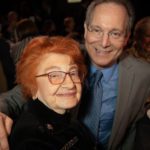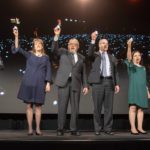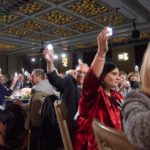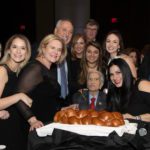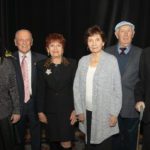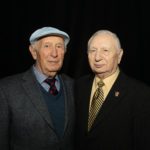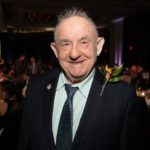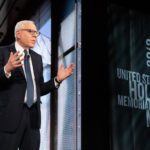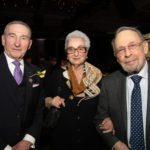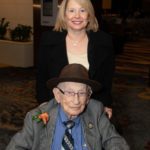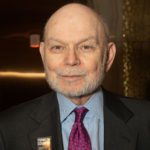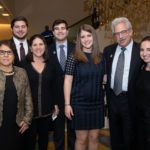U.S. Holocaust Memorial Museum Marks 25 Years (photos)
By • April 11, 2018 0 3621

When 9-year-old Philip Lazowski was pushed by his mother from a second-floor window of the Kino movie theater in the Polish town of Zetl in August 1942, she told him “I want you to be somebody and tell the world what’s going on. Save yourself.” He never saw her again. Lazowski would survive by living in the woods for two years with others trying to save themselves from the Nazi killing machine. The book about his experience, “Faith and Destiny,” is set to be made into a movie, according to Rabbi Lazowski, who was chosen to light one of six memorial candles at the Capitol.
The U.S. Holocaust Memorial Museum in Washington, D.C., presented the 2018 Elie Wiesel Award, the institution’s highest honor, to all Holocaust survivors during the museum’s 25th Anniversary National Tribute Dinner on April 9, during the Days of Remembrance, when the museum leads the nation in remembering the victims of the Holocaust. The event, which took place at the Marriott Marquis, was attended by more than 1,700 persons, including 138 holocaust survivors and their families.
Established in 2011, the Elie Wiesel Award is named in honor of its inaugural recipient, Nobel Peace laureate and museum founding chairman Elie Wiesel. Wiesel, who died on July 2, 2016, at the age of 87, was the featured speaker five years prior at the museum’s 20th anniversary dinner. The keynote address at this year’s dinner was delivered by philanthropist David M. Rubenstein.
The last of the Nazi camps were liberated 73 years ago. Virtually all of the survivors in attendance escaped as children. One of the dinner guests, Albert Garih, will reach 90 in the next two months. During the final days of the French occupation, he was ‘hidden’ in a Catholic boarding school. Another attendee, 12-year old Irene S. Rehbock of Springfield, Virginia, was spirited out of Hamburg, Germany, in 1938 aboard the Kindertransport, an organized rescue of nearly 10,000 Jewish children sent from Europe to England in the months leading up to the outbreak of World War II.
Earlier in the day, a number of survivors and their family members assembled in Emancipation Hall at the U.S. Capitol for the National Commemoration of the Days of Remembrance. Benjamin Ferencz was the featured speaker. At 99, he is the last surviving attorney from the Nuremberg trials. When he was 27 years old in his first case at Nuremberg, he successfully prosecuted 22 high-ranking Nazi members of the infamous Einsatzgruppen killing squads. His slogan today: “Law, not War.”
Several of the survivors, like Frank Lieberman of Bethesda, Maryland, continue to donate their valuable time to the Holocaust Museum as living reminders. Ten-year-old “Franz” and his family emigrated from Germany less than a month before Kristallnacht, the “Night of Broken Glass.” Frank is looking forward to a family reunion next week with his 30 descendants, his very personal answer to Hitler’s policy of genocide.
Bernhard Kiewe, his mother, his sister and two brothers left Konigsburg, Germany, in 1939 and headed for Shanghai,China. They were joined by his father two months later when he was released from jail. Bernie lived in Shanghai for 10 years until an aunt sponsored his travel to America when he was 18.
Henry Greenbaum of Bethesda, Maryland, just celebrated his 90th birthday. Accompanied by a dozen of his children and grandchildren, he was invited to lead in the recitation of the “HaMotzi,” the traditional Jewish blessing before the meal. Greenbaum spent his years 12 through 17 in one camp or another. He was born Chuna Grynbaum in Starachowice, Poland, on April 1, 1928. In 1944, Henry was deported to Auschwitz and incarcerated in the Buna-Monowitz subcamp, where the I.G. Farben Company owned a factory established for the purpose of producing synthetic rubber and fuel. As the Soviet army approached, Greenbaum was evacuated to Flossenbürg, a concentration camp near the Czechoslovakian border. When American forces neared Flossenbürg a few months later, the prisoners were sent toward Dachau on a death march. He was liberated at Neunburg vorm Wald on April 25, 1945, by American soldiers from the 11th Armored Division. When liberated, Greenbaum weighed only 75 pounds on a diet of leaves. Today, Greenbaum serves as a volunteer at the U.S. Holocaust Museum, sharing his story with visitors.
David Rubinstein, in his keynote address, reminded the audience that, when people gather in the future for the Holocaust Museum’s 50th anniversary, there will be no survivors alive to bear witness. As the survivors die off, there will not be anyone to personally pass on the legacy of the Holocaust. People will be left to read about it or go to places like Yad Vashem (in Jerusalem) and the Holocaust Museum in Washington. This is why it is imperative to preserve the stories and the evidence.
More than 43 million people, including 15 million students, have visited the National Holocaust Memorial Museum, which is located on the National Mall in the shadow of the Washington Monument. Five million have seen its traveling exhibitions in the United States and Europe, and 20 million each year rely on online resources available in 16 languages.
Raising money is crucial, as the museum is entirely privately funded. “Twenty-five years is only a beginning,” said Museum director Sara Bloomfield, “and we are building an institution for the ages to keep Holocaust memory alive and at work in the world. Our campaign will secure the resources to ensure that the Museum can remain relevant and responsive. Not only can we do this; we must do this. We owe the survivors and victims no less.”
The “Never Again: What You Do Matters” campaign set out five years ago to raise $540 million by the museum’s 25th anniversary. It reached that target 18 months ahead of schedule and has now brought in $715 million from 366,000 donors. Museum Chairman Howard M. Lorber announced that it would increase its goal to $1 billion by 2023, its 30th year.
When World War II ended in 1945, six million European Jews were dead: targeted victims in the Nazis’ calculated program of genocide. More than one million of the victims were children. Unfortunately there is still an alarming rise in Holocaust denial and anti-Semitism, as well as genocide and threats of genocide in all parts of the world. The U.S. Holocaust Memorial Museum teaches that we all have a role in shaping the future by understanding the past, so that “Never Again” will be more than an aspiration.
View Jeff Malet’s photos from the U.S. Holocaust Memorial Museum’s 25th Anniversary Commemoration by clicking on the photo icons below.
- The U.S. Army Band under the direction of First Lieutenant Philip D. Tappan opens the program with a selection of solemn Jewish melodies. (photo by Jeff Malet)
- Holocaust survivors Samuel Frankel, 94, and Rina Frankel, 83 of Shaker Heights, Ohio came to the Holocaust Museum groundbreaking, we were there for the opening 25 years ago (photo by Jeff Malet)
- Reading from this list. Presentation of the flags of US Army Liberating Divisions carried by the 3rd US Army Infantry (The Old Guard). (photo by Jeff Malet)
- Friends U.S. Senator Ben Cardin and Howard Kaidanow, both of Baltimore Md. Both Kaidanow’s mother and father were killed on the same day in 1942, when Kaidanow was thirteen. He and his brother narrowly escaped the squads by hiding under hay in the barn for a few days before joining their relatives in Kurenec, Belarus. They spent the remaining years of the war in hiding while Kaidanow served as a messenger and spy for the Partisan movement. He was in Belarus when the Soviets liberated the region in 1944. (photo by Jeff Malet)
- Presentation of the flags of US Army Liberating Divisions carried by the 3rd US Army Infantry (The Old Guard). (photo by Jeff Malet)
- Benjamin Ferencz chokes up when he recounts witnessing victims of the Holocaust shortly after the camps were liberated in 1945 as a young corporal in Patton’s Third Army. At 99, Ferencz is the last surviving attorney from the Nuremberg trials. Photo by Jeff Malet. (photo by Jeff Malet)
- Survivor Fed Flatow watches the proceedings (photo by Jeff Malet)
- Holocaust survivors Frank Liebermann and Sylvia Rozines participate in a candlelighting ceremony at the Capitol. (photo by Jeff Malet)
- Survivors Felice Zimmern Stokes and Michel F Adler. Stokes was hidden with a non-Jewish family for 3-1/2 years in a small town in France. (photo by Jeff Malet)
- Bertini Ackos Bergstein and Rabbi Philip Lazowski (photo by Jeff Malet)
- Memorial Candlelighting at the Capitol (photo by Jeff Malet)
- Over 100 survivors of the Holocaust attended the National Commemoration of the Days of Remembrance at the Capitol on April 9. (photo by Jeff Malet)
- Fred and Sue Flatow, with daughter Ruth Shapiro. (photo by Jeff Malet)
- Holocaust survivors Kurt and Marilyn Wallach. A Navy veteran, Kurt remembers the deaths of 200 family members during the Holocaust. Together they established a charitable lead annuity trust that will benefit the museum. (photo by Jeff Malet)
- Hazzan Asa Fradkin of Congregation Beth El with wife Sarah. He sang El Maley Rachamim, the Jewish Prayer for the Soul of the Departed, at the ceremony at the Capitol (photo by Jeff Malet)
- French Holocaust survivor Joel Nommick Joel was born in 1942, and like the rest of his family, lived under a false name until liberation. (photo by Jeff Malet)
- Isak N. Banon (Baltimore Md.) at age 14 escaped over the Yugoslav Mountains to Italy in the middle of the war. (photo by Jeff Malet)
- Prior to the U.S. Holocaust Memorial Museum’s 25th Anniversary National Tribute Dinner, the keynote speaker David Rubenstein, co-founder and co-executive chairman of The Carlyle Group, chats with Ellen Safir, Chief Executive Officer and Chief Investment Officer of New Century Advisors LLC.
- Frank Lieberman (Bethesda, Md. (left) greets Irving Holt (Freehold N.J.) (photo by Jeff Malet)
- Frank Lieberman is looking forward to a family reunion next week with his 30 descendants, his very personal answer to Hitler’s policy of genocide. (photo by Jeff Malet)
- At age 15, Michel Margosis and his family fled from France over the Pyrenees into Spain. From there, Michel was sent to the United States in 1943. (photo by Jeff Malet)
- Frank Kohn and his mother Ruth Kohn (92) from Springfield Va. Ruth and her family arrived in the Dominican Republic on December 7, 1941, the day Pearl Harbor was attacked by Japan. (photo by Jeff Malet)
- Sara J. Bloomfield, Director, United States Holocaust Memorial Museum, speaks on “The Museum at 25.” (photo by Jeff Malet)
- Howard M. Lorber, Chairman, United States Holocaust Memorial Museum, talks about “The Campaign of the Future.” (photo by Jeff Malet)
- Raising a memorial candle (photo by Jeff Malet)
- Raising a memorial candle (photo by Jeff Malet)
- Survivor Henry Greenbaum of Bethesda, Md., surrounded by a dozen of his children and grandchildren, was invited to lead in the recitation of the “HaMotzi,” the traditional Jewish blessing before the meal. (photo by Jeff Malet)
- (left to right) Esther and Howard Kaidanow; Sarah Meller; Jerry Kaidanow; Ellen Kaidanow, Joseph Kaidanow (photo by Jeff Malet)
- Brothers Howard and Joseph Kaidanow fled from Belarus. in what was then Poland. The brothers narrowly escaped the squads by hiding under hay in the barn. Howard served as a messenger and spy for the Partisan movement. He was in Belarus when the Soviets liberated the region in 1944. (photo by Jeff Malet)
- Bernhard Kiewe, his mother, sister, and 2 brothers left Konigsburg, Germany in 1939 and headed for Shanghai China. They were joined by his father 2 months later when he was released from jail. Bernie lived in Shanghai for 10 years until an Aunt sponsored his travel to America when he was 18. (photo by Jeff Malet)
- David Rubinstein, in his keynote address, reminded us that when people gather in the future for the Holocaust Museum’s 50th anniversary, there will be no survivors alive to bear witness. (photo by Jeff Malet)
- Allan M. Holt, Vice Chairman, United States Holocaust Memorial Museum announces the presentation of the 2018 Elie Wiesel Award, the institution’s highest honor, to all Holocaust survivors (photo by Jeff Malet)
- Survivors Nat Shaffir (left) and Jill and Kurt Pauly (photo by Jeff Malet)
- Survivor Boleslaw “Bolek” Brodecki and his daughter Roma Brodecki
- Born in the refugee camp. Joseph Brodecki led the international fundraising efforts to build the U.S. Holocaust Memorial Museum and was a presidential appointee to the museum’s council. (photo by Jeff Malet)
- Three generations of the Lansky Edlin Family from Atlanta Ga. (photo by Jeff Malet)

